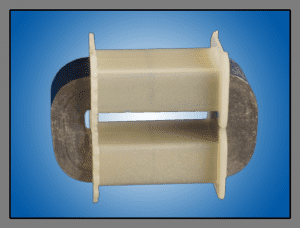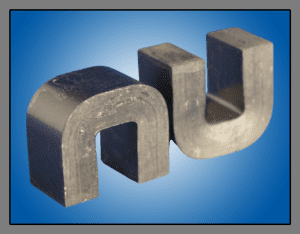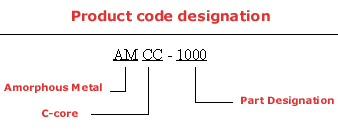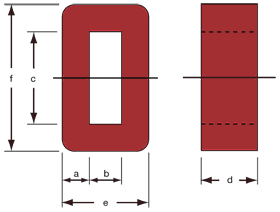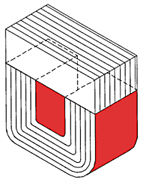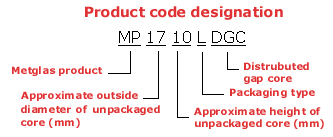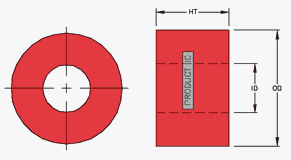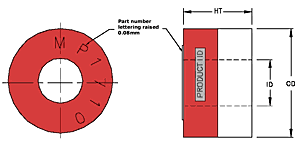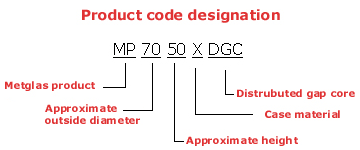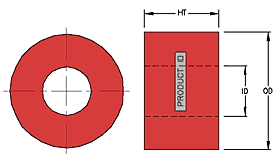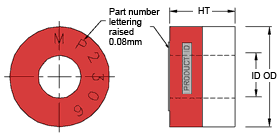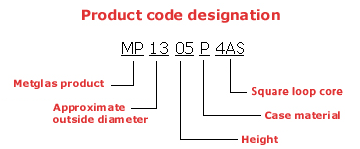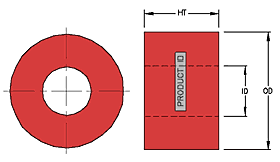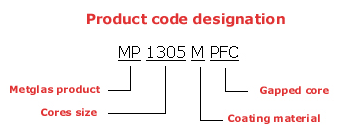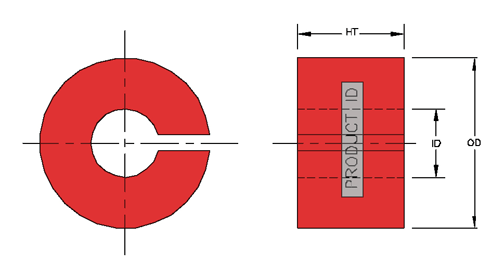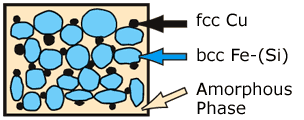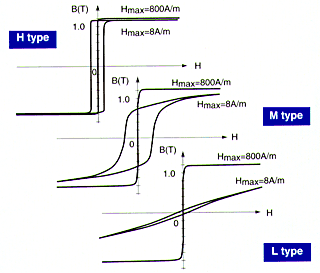ABOUT AMORPHOUS CORES
Amorphous metals are produced using a rapid solidification technology where molten metal is cast into thin solid ribbons, by cooling at a rate of one million °C/second. Amorphous magnetic metal has high permeability due to no crystalline magnetic anisotropy.
Amorphous cores are made from a very thin Iron based amorphous ribbon, approximately 25 µm thick. Amorphous ribbon is wound into toroidal and oval shapes. Our enhanced ribbon
resulting in more core cross-sectional area being occupied by the amorphous ribbon, allowing for ultra-low loss amorphous cores. These cores are annealed and impregnated with a special epoxy, which permits cutting gaps in toroidal cores and cutting ovals in half to form a set of cut C-Cores. Several oval cores can be wound and cut into E-shaped cores for multi-phase applications.
TECHNICAL ADVANTAGE
Where typical ferrite cores can only operate up to a flux saturation level (Bsat) of 0.49 Tesla, a amorphous metal core can operate at 1.56 Tesla. Combined with operating at permeability similar to high-end ferrites, and the flexibility of manufacturing large cores sizes, these cores can be an ideal solution for many of these components.
Low Losses
Amorphous magnetic cores have superior magnetic characteristics, such as lower core loss, when compared with conventional crystalline magnetic materials. This is because the amorphous structure responds to changes in magnetic fields (alternating AC fields) more readily than other materials, providing a BH loop that essentially exhibits no hysteresis losses.
Magnetic field changes also induce currents, called eddy currents, which are an additional source of loss. These losses become significant at higher frequencies when using thicker laminations. The super thin nature of the amorphous ribbon limits these losses by reducing the circulation of these eddy currents.
APPLICATIONS
When used in higher frequency applications, Amorphous cores are more efficient, smaller, and lighter than cores made of silicon steel, ferrite, and powdered iron, by providing high saturation flux density and low magnetization losses. These properties make amorphous highly suitable for power inductors at frequencies ranging from 8 to 100kHz.
C-Cores
- AC Reactor cores in Charging Inverters
- AC and DC Filter reactors in high-frequency converters/inverters
- Medium and high-power switching power supply
- Filter inductor in AFE
Characteristics
- High saturation flux density - reduce core volume
- Rectangular form - easy coil assembly
- Air gaps can be used to reduce DC-bias-saturation
- Low core loss
- Good temperature stability of Saturation Induction and Permeability
AMORPHOUS C-CORES SETS
These amorphous cores wound in a C-Core configuration, which is ideal for AC Reactors and DC Inductors from 10 to 1000+ amperes. The C-Core also allows for single- phase and three-phase inductor designs.
Amorphous metal C-Cores allow for operation at higher frequencies at the same flux level. Whereas traditional steel cores need to operate at
increasingly lower flux densities as the frequency increases. In order to compensate for running at lower flux densities, significantly more material is needed.
Even with additional material higher temperatures still occur. Another contributor to lowering losses is the I2R of the winding. A physically smaller amorphous core reduces the mean length per turn, hence the I2R copper losses and copper costs are lower. Further improvements can be realized by using Nanocrystalline C-Cores.
Three phase designs can be done with standard single-phase cores or a custom three-phase amorphous metal core can be constructed in a two-piece set as shown.


WINDING OPTIONS
For higher current applications, these cores open up new options for the conductor winding process that is not easily achievable for toroidally constructed cores:
- Copper foil
- Large gauge square conductors
- Edge or disc winding
In each of the above options, the winding can be accomplished on a separate mandrel and assembled onto the C-Core after the winding process. Litz wire (a special type of multistrand wire) is commonly used for high current/high frequency designs. However, terminating litz wire for these applications can be expensive. An alternative to consider is disc or edge winding. This involves winding a rectangular wire that has a relatively high aspect ratio on its edge. The quasi-planar structure of this thin rectangular wire reduces the skin effect, but not as much as when using litz wire. Although copper or aluminum foil can also reduce skin effect properties, other parasitic winding effects need to be considered when using this winding method. Other advantages of using amorphous cores are: lower copper loss, reduced DCR, smaller size, and improved heat dissipation.

Low loss switching devices such as SiC MOSFETs that allow for operating frequencies of 100kHz, are now becoming cost effective for the high-power electronics designs. In the past, traditional EI and UI laminated inductors using 3% Ni and silicon grain-oriented steel could be used with little problem. Three percent nickel and silicon grain-oriented steel designs become physically large above 1kHz. These traditional laminate materials need to operate at a very low flux density at these frequencies, resulting in higher temperatures and much larger core sizes, than with a comparable amorphous core design. These are summarized in the below chart:
Amorphous & Nanocrystalline cores for high frequency inductors verses competitive materials
| Parameters |
Nanocrystalline C-Core |
Amorphous C-Core |
Iron Powder |
6% Si Steel |
3% Si Steel |
Ferrite |
| Bsat(T) |
1.23 |
1.56 |
1.0 to 1.4 |
1.2 |
1.85 |
0.35 |
| Permeability |
6,000 |
3,000 |
2 to 75 |
4,100 |
1,000 |
2,500 |
| Power Loss (W/Kg) |
10 |
35 |
550 |
185 |
275 |
65 |
| Turns |
1 |
2 |
8 |
2 |
4 |
5 |
This design assumes 50% permeability with 50 Oe of bias, 2500 perm ferrite was used for comparison and core determined at 20 kHz and 2 kg BAC
When comparing Iron Powder to Amorphous core. The Amorphous core will tend to be less expensive, and have lower losses, smaller physical size, better heat dissipation, and are mechanically rugged. The Nanocrystalline core will have the lowest power loss and smaller size. However, cost of the Nanocrystalline core will be slightly higher.
Use these tools to help you choose the best core for your DC Inductor and AC Reactor design:
DESIGN CALCULATORS
Design Data:
Technical Charts
Magnetization Curves
For larger kilowatt power supplies, high frequency transformers using these C-core offer higher saturation induction of 1.56 Tesla and lower losses allowing for:
- higher efficiency
- lower transformer weight
- reduced transformer volume
AMORPHOUS BLOCK CORES - POWERLITE® FORMS
We produce rectangular shapes of amorphous metal cores by stacking layers of laminations made from amorphous metal ribbon. An adhesive rated for a continuous operating temperature of 155°C holds the laminations together.
These forms offer a unique combination of high saturation induction (1.56 T), high permeability and low core loss and can be configured into various shapes, allowing for one large gap to be distubuted across several smaller gaps, reducing fringing flux, and core loss.
Possible configurations:

Hybrids can be designed using c-core sections with corresponding bricks for unique shapes
Applications: Medium Frequency and High Power Inverters
Technical data sheet
Toroidal Amorphous Cores
These are offered in various amorphous metals depending on your application
DESIGN CALCULATORS
| Application |
Design Tool |
Material |
| Common mode chokes |
Common Mode Calculator |
Nanocrystalline |
| Spike killers |
N/A |
Nanocrystalline |
| Magnetic Amplifiers |
MagAmp Calculator |
Cobalt Alloy |
| Differential mode chokes |
Normal Mode Calculator |
Partly crystallized iron alloy |
| Products |
Material |
Comments |
| MicroLite® |
Partly crystallized iron alloy |
Sizes to match industry standard 125 permeability material |
| MicroLiteXP® |
Partly crystallized iron alloy |
Sizes to match application requirements. |
| MagnaPerm® |
Cobalt Alloy |
|
| Finemet® |
Nanocrystalline |
Common mode cores |
OUTPUT INDUCTOR CORES - MicroLite® Toroidal Cores
These are Metglas® cores manufactured with iron-based Metglas®
amorphous Alloy-SA1. They offer a unique combination of high saturation induction, high permabiliity and the lowest core loss available for high frequency choke cores allowing the use of significantly smaller sizes than possible with conventional materials. Available in both coated and boxed cores.
Coated MicroLite Cores
Boxed MicroLite Cores
Applications: DC Output Inductors; Flyback Transformers; Differential Mode in Chokes; PFC Boost Chokes - Continuous Mode.
Links and data sheets for download
Core Data Sheet
To choose the best core for your design download the Output Inductor calculator: Executable file, or Zip file
DIFFERENTIAL MODE INDUCTOR CORES - MicroLiteXP® Toroidal Cores
This is an amorphous alloywhich also non-crystalline in nature. Metglas® MICROLITE XP cores operate cooler and have lower core losses than cores made of conventional crystalline materials such as powdered iron, ferrite or sendust. MICROLITE XP's energy-efficient properties reduce the size of powder sources for demanding applications in the electronics industry.
Applications: Differential Input Inductors, PFC Inductors, Flyback transformers, and VRM Inductors.
Links and data sheets for download:
Core Data Sheet
To choose the best core for your design download the Differential Mode Inductor calculator: Executable file, or Zip file
COBALT BASED AMORPHOUS CORES - MagnaPerm® High Permeability Cores
These cores are manufactured with cobalt-based Metglas® amorphous alloy 2714A for high frequency applications. These flat loop toroidal cores offer a unique combination of ultra-high permeability, high saturation flux density and extremely low core loss for electronic component designers.
Applications: EMI Common Mode Filtering; Telecommunications and Data Communications Interface Transformers; High Accuracy Current and Pulse Transformer Ground Fault Protection Devices.
Links and data sheets for download:
Core Data Sheet
SQUARE LOOP - MAG-AMPS -CORES - Metglas® Amorphous Alloy 2714A
These cores are manufactured with cobalt-based Metglas® amorphous alloy 2714A which allow the design of MAG AMP that can operate at higher frequencies than previously possible. Their combination of magnetic properties enables these MAG AMP cores to provide unparalleled precision and efficiency in output regulation. Available in both coated and boxed cores.
Applications: Saturable Reactors; Magnetic Amplifiers.
Links and data sheets for download
To choose the best core for your design download the MAG-AMP calculator: Executable file, or Zip file
GAPPED TOROIDAL AMORPHOUS CORES - MicroLite® 100µ
These cores are ideal candidates for PFC boost inductor applications in power supply ranges from 300 to 6kW (for higher power design see Powerlite). Microlite 100μ are tape wound amorphous toroidal cores with a small gap, which allows the core to achieve permeabilities less than 245. The amorphous metal core is stable over a wide temperature range and offers a design with fewer and smaller gaps than comparable E-core ferrites. The fewer gaps and smaller gap size greatly reduces EMC concerns from fringing flux and stray field. Most designs can be constructed with few turns and lower losses providing a smaller more cost effective design. In some cases these cores maybe a good alternative for differential input inductors, and SMPS output inductors. Various standard core sizes are available. For the ultimate PFC boost inductor solution contact us directly on our new Advanced Amorphous A-AL material.
A-AL - Is a powder alloy "distributed gap" Amorphous core
MicroLite® 100µ Core Properties vs. The Competition
| Parameters |
Microlite 100m |
Iron Powder |
MPP 60m |
Kool Mu 60m |
Ferrite |
| Bsat(T) |
1.56 |
1.0 to 1.4 |
.75 |
1.1 |
0.35 |
| Perm |
100 |
75 |
60 |
60 |
Gap Dependent |
| Power Loss (W/Kg) |
140 |
680 |
50 |
120 |
<65 |
| % Permeability at 100 Oe |
75 |
25 |
50 |
45 |
Gap Dependent |
This comparison was done using 2500 perm ferrite and core loss comparison performed at 100 kHz and 1 kGBAC
Standard MicroLite® 100µ Cores
Design Data:
Technical Charts
To choose the best core for your design download the PFC calculator: Executable file, Zip file
Advanced Amorphous A-AL
These cores are manufactured by pulverizing amorphous ribbon and pressing this powder into toroidal shapes, using amorphous alloy. Allowing the designer of PFC boost inductors to reduces size and power loss as compared to conventional solutons. This A-AL material is a unique in its combination of low core loss and high DC bias which enables these cores to provide unparalleled precision and efficiency. Contact us for availablity in both coated and
boxed cores.
How amorphous ribbon is made
 The casting process
The casting process Ribbon is cast in widths up to 8 inches in wide and then is slit to width required for winding. Special winding machines wind the ribbon in to various Toroidal, Oval and C-core shapes. Cores then are further process via cutting, coating, annealing according to standard offering and customer requests.
Nanocrystalline Amorphous Metal
Nanocrystalline amorphous metal is produced by rapid quenching a molten alloy to produce a amorphous metal and then heat treating this alloy at higher than its crystallization temperature The alloy forms Nanocrystalline grain size of approximately 10 nm in the amorphous metal.
Annealing changes BH loopsM type material is done with no magnetic field applied during annealing M type material is done with no magnetic field applied during annealing We produce H and L type BH loops by annealing with magnetic fields oriented either parallel or perpendicular to the ribbons surface.
Advantages are:
- High saturation magnetic flux density, more than 1 Tesla
- High permeability over 10,000u at 100kHz
- Excellent temperature characteristics. Very high Curie temperature (570°C) resulting in small permeability variation (less than +/-10%) at a temperature range of -40°C to 150°C.
- Less affected by mechanical stress. Because of the low magnetostriction permeability and core loss changes have very small changes.
- Very low audio noise emission. Lower magnetostriction significantly reduces audible noise emission when the voltage and current applied to the core at audible frequency range.
General Informational Brochure 

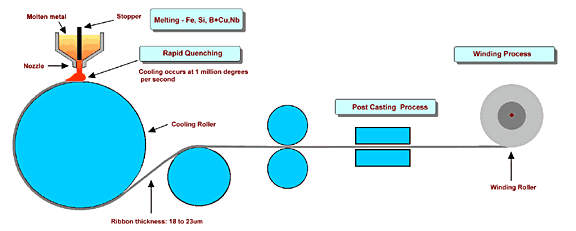 The casting process Ribbon is cast in widths up to 8 inches in wide and then is slit to width required for winding. Special winding machines wind the ribbon in to various Toroidal, Oval and C-core shapes. Cores then are further process via cutting, coating, annealing according to standard offering and customer requests.
The casting process Ribbon is cast in widths up to 8 inches in wide and then is slit to width required for winding. Special winding machines wind the ribbon in to various Toroidal, Oval and C-core shapes. Cores then are further process via cutting, coating, annealing according to standard offering and customer requests.

